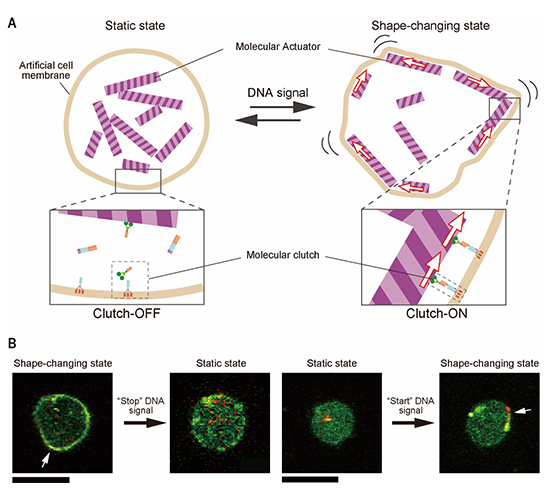A team of researchers at Tohoku University and Japan Advanced Institute of Science and Technology just developed a molecular robot consisting of biomolecules, such as DNA and protein. Developed by integrating molecular machines into an artificial cell membrane, the molecular robot can change the cell's shape in a manner much like that of an amoeba. The researchers can start and stop the robot's shape-changing function by optically triggering sequence-designed DNA signals.
Impressively, this is the first time that a molecular robotic system was able to recognize signals and control its shape-changing function. In the near future, these molecular robots could likely function in a way similar to living organisms.
By using biomolecules including DNA and proteins, living organisms perform important functions. For example, white blood cells can chase bacteria by sensing chemical signals and migrating toward the target. When it comes to chemistry and synthetic biology, elemental technologies for making various molecular machines, like sensors, processors, and actuators, are designed with biomolecules.

A schematic diagram of the molecular robot. Image source: Tohoku University.
A molecular robot is an artificial molecular system that's built by integrating molecular machines. The research team believes that the realization of this system could lead to a massive breakthrough: a bio-inspired robot created on a molecular basis.
At about one-millionth of a meter, the molecular robot developed by the researchers is tiny, though similar in size to human cells. It consists of a molecular actuator, composed of protein, and a molecular clutch, composed of DNA. The shape of the robot's body can be changed by the actuator, and the transmission of the force generated by the actuator can be controlled by the molecular clutch. The clutch itself has two parts: an anchor unit and a motor unit. When these two are connected via linker DNA, the motor unit is able to interact with the cell membrane. When disconnected, the motor unit cannot interact, and the membrane assumes a spherical shape.
Through experiments, the researchers demonstrated how the molecular robot could start and stop the shape-changing behavior in response to specific photoresponsive DNA signals that are triggered using UV light.
“With more than 20 chemicals at varying concentrations, it took us a year and a half to establish good conditions for working our molecular robots,” said associate professor Shin-ichiro Nomura at Tohoku University's Graduate School of Engineering, who led the study. “It was exciting to see the robot shape-changing motion through the microscope. It meant that our designed DNA clutch worked perfectly despite the complex conditions inside the robot.”
Such a molecular robot with components designed at a molecular level and who can function in a small and complicated environment, such as the human body, is expected to expand the possibilities of robotics engineering. The results of this study could lead to technological developments that could help solve important medical issues, such as a monitoring robot that checks for environmental pollution.
Source: Tohoku University
Advertisement
Learn more about Electronic Products Magazine





